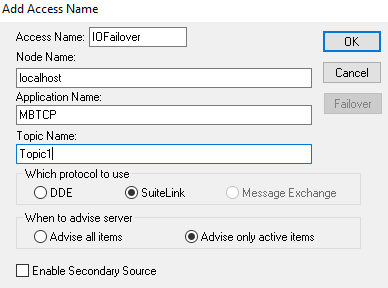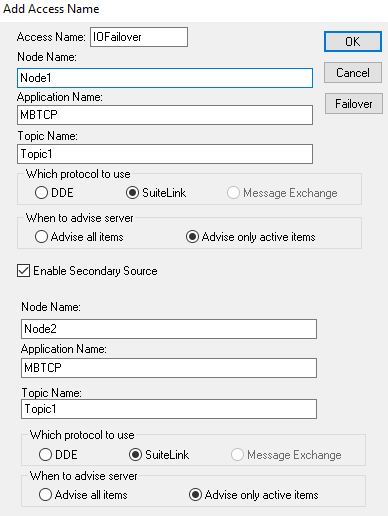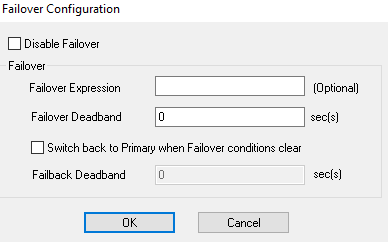Configuring Automatic I/O Failover in InTouch 9.5
SUMMARY
The InTouch HMI reduces engineering development times by providing a one-click option for I/O Failover, which enables you to automatically switch I/O servers when I/O communication fails. Users can configure I/O server switching via the graphical user interface (GUI) in WindowMaker. Script functions are also provided to further extend the I/O communication failover features.
APPLIES TO
- AVEVA InTouch 9.5 or later
PROCEDURE
To configure I/O failover for an Access Name, click the “Enable Secondary Source” option from the Add Access Name dialog box. This expands the dialog box so you can enter a secondary source.
Note: If WindowViewer is active, you are not able to access the Failover configuration from WindowMaker.

Automatic I/O Failover occurs when you check the Enable Secondary Source, regardless of the default Failover Configuration parameters. For additional control over Failover functionality, use the Failover button to access additional parameters.

Failover Configuration

- Disable Failover is for enabling and disabling failover for this Access Name.
- Note: This option will be unavailable until you save the Access Name configuration at least once.
- Script Function: IODisableFailover(Accessname,Option) Enables and disables failover during runtime (specifying the “Option” as 1 enables failover and 0 disables failover).
- Failover Expression is a discrete result, usually an InTouch tag can be used to trigger the failover.
- NOTE: The Failover expression can be any Boolean expression.
- Failover Deadband is the delay before switching to the secondary source from the primary source when I/O communication fails. The default value 0 seconds.
- NOTE: The failover band is the delay in seconds before switching from the primary access name to the secondary access name. A failover will be triggered when either the expression or an I/O communication failure has been true for the deadband period. When the expression is left blank, the failover will occur as soon as there is an I/O communication failure.
- SCRIPT: IOForceFailover(AccessName) Forces failover for a specific access name. The failover is logged in the logger.
- NOTE: Once you have forced failover to a secondary I/O source, the primary I/O source will not be restored regardless of the parameters that you configured at design time. Once you click the button and call this function a second time forcing the connection is forced back to the Primary with a second call of this function, then the failover pair continues to operate in the normal configured manner.
- Switch back to Primary when Failover conditions clear specifies whether InTouch should switch back to the primary source when I/O communication returns.
- Fail-back Deadband is the delay before switching back to the primary source from the secondary source when I/O communication returns. The default value is 0 seconds. This will cause failover and fail-back to occur immediately.
A fail-back will be triggered when both the expression and any associated I/O communication failure have cleared for the and period. When the expression is left blank, the fail-back occurs as soon as the I/O communication failure condition clears.
All Industrial Software Solutions Tech Notes are provided "as is" without warranty of any kind.